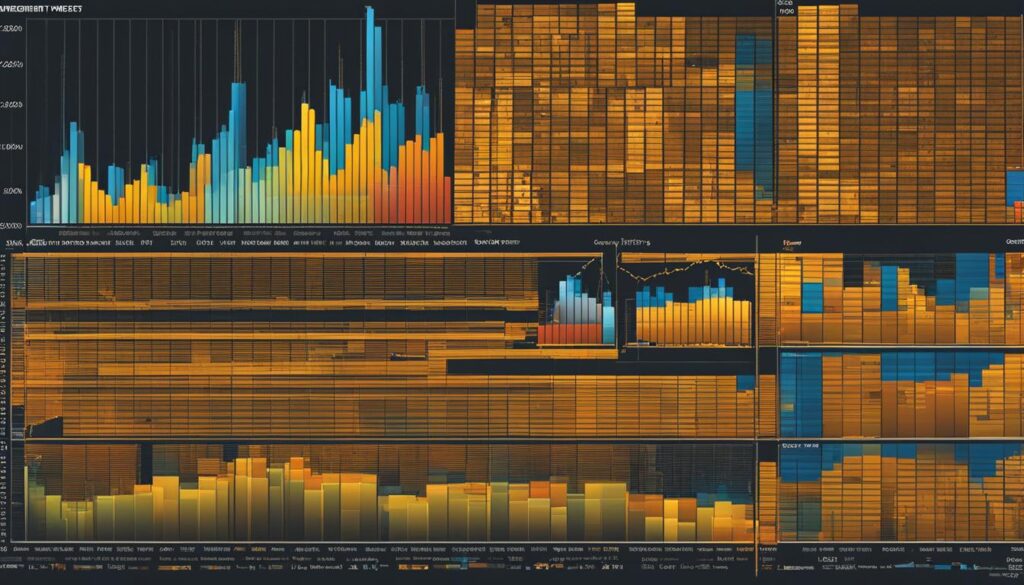When it comes to investment analysis, diversification and risk reduction are key considerations. In recent years, commodity index investing has emerged as a practical approach to achieving these goals. Commodity indices offer investors the opportunity to access a unique asset class that is uncorrelated with traditional assets like stocks and bonds.
Commodity index investing involves buying baskets of commodities, which replicate the performance of a commodity index. This approach allows investors to enhance their risk-adjusted returns and add an additional layer of diversification to their portfolios.
Investment analysis with commodity indices provides valuable insights into market trends and potential opportunities. By analyzing the performance and composition of commodity indices, investors can make more informed investment decisions and optimize their portfolios.
Key Takeaways:
- Commodity index investing offers diversification and risk reduction benefits.
- Investors can access a unique asset class with low correlation to traditional assets.
- Commodity indices can be replicated through buying baskets of commodities.
- Investment analysis with commodity indices provides valuable market insights.
- Optimizing portfolios through commodity index investing can lead to enhanced risk-adjusted returns.
Motives for Commodity Index Investing
Commodity index investing is driven by the desire to achieve portfolio diversification and reduce risk. As an investor, I understand the importance of constructing portfolios that maximize expected returns while minimizing exposure to risk. This is where commodity index investing comes in.
Commodity index investments offer a unique asset class that has historically shown low correlation with traditional assets like stocks and bonds. By including commodity index investments in a diversified portfolio, I can access an additional layer of diversification, reducing the potential impact of any single asset on the overall portfolio performance.
The principles of modern portfolio theory guide my motives for engaging in commodity index investing. This widely accepted theory suggests that an optimal portfolio combines assets with different return patterns and risk profiles to achieve a more attractive risk-adjusted return. By incorporating commodities into my investment strategy, I strive to achieve this optimal mix.
“Commodity index investing provides an opportunity to enhance risk-adjusted returns through exposure to a unique asset class that complements traditional investments.”
Moreover, commodity index investing offers a hedge against inflation. Commodities, such as precious metals and energy resources, have historically demonstrated the ability to retain their value or even appreciate during times of inflation. By including these assets in my portfolio, I aim to protect my investments against the eroding effects of inflation.
The motives behind commodity index investing are further reinforced by the potential for enhanced returns. While commodity prices can be volatile, they can also provide attractive returns during certain market conditions. By carefully selecting diversified commodity index investments, I seek to capture these opportunities.
Key motives for commodity index investing:
- Diversification: Access a unique asset class with low correlation to traditional assets.
- Risk reduction: Enhance the risk-adjusted returns of a portfolio.
- Hedge against inflation: Protect investments from the eroding effects of inflation.
- Potential for enhanced returns: Capitalize on opportunities within commodity markets.
By considering these motives, I can strategically incorporate commodity index investments into my portfolio and enhance its overall performance.
| Benefits of Commodity Index Investing | Considerations |
|---|---|
| 1. Portfolio diversification | 1. Market volatility |
| 2. Inflation hedge | 2. Commodity price volatility |
| 3. Risk reduction | 3. Liquidity concerns |
| 4. Potentially enhanced returns | 4. Constant monitoring and rebalancing |
Forms of Commodity Index Investments
Commodity index investments offer investors a range of options to gain exposure to commodity markets. These investments come in various forms, allowing investors to tailor their strategies to meet their objectives and preferences.
Managed Funds
One common form of commodity index investment is through managed funds. Managed funds pool investors’ money and are managed by professional fund managers. These funds typically aim to replicate the performance of a specific commodity index, providing investors with diversified exposure to a basket of commodities.
Exchange-Traded Funds (ETFs)
Exchange-Traded Funds (ETFs) are another popular choice for commodity index investments. ETFs trade on stock exchanges, allowing investors to buy and sell shares throughout the trading day. They are designed to closely track the performance of a specific commodity index and offer investors the flexibility of buying and selling in real-time.
Exchange-Traded Notes (ETNs)
Exchange-Traded Notes (ETNs) are debt securities that provide exposure to commodity indexes. ETNs are typically issued by financial institutions and promise to pay investors the return of a specific commodity index, minus any fees or charges. These notes trade on exchanges, providing investors with convenient access to commodity markets.
Over-the-Counter (OTC) Return Swaps
Over-the-Counter (OTC) return swaps are another form of commodity index investment. In a return swap, one party agrees to pay the return of a commodity index to another party in exchange for a specified payment. These swaps are traded privately between institutional investors and offer flexibility in structuring commodity index exposures.
Commodity index investments are typically benchmarked to transparent and well-diversified commodity indexes like the S&P-GSCI and DJ-UBSCI. These indexes provide a reliable reference point for tracking the performance of commodity markets.
By offering a range of investment options, commodity index investments allow investors to choose the approach that aligns with their investment goals and risk tolerance.
Measurement of Commodity Index Investments
Measuring the size and flow of commodity index investments is crucial for analyzing their impact on the market. Understanding the scale of these investments provides valuable insights into market trends and investor sentiments. One widely used tool for measuring commodity index investments is the Commitment of Traders (COT) reports.
The COT reports, published by the Commodity Futures Trading Commission (CFTC), offer a comprehensive view of the positions held by commodity index traders and other market participants in the futures market. These reports provide valuable data on the level of investment in commodity indexes, helping investors and analysts gauge market sentiments and identify potential trends.
By studying the COT reports, analysts can estimate the total commodity index investment in the U.S. and gain insights into the composition of these investments. The reports reveal the net positions of various market participants, including commercial traders, non-commercial traders, and small traders.
These reports enable market participants to understand the flow of funds into and out of commodity index investments, which can influence market dynamics and prices. By tracking the changes in positions over time, it becomes possible to identify shifts in investor sentiments and potential market trends.
Insights from the COT Reports
The COT reports provide valuable insights into the behavior and positioning of commodity index traders. By analyzing the data, analysts can:
- Identify trends in investor sentiment towards specific commodities or sectors
- Monitor changes in the overall level of investment in commodity index funds
- Assess the impact of commodity index investments on futures prices
- Understand the relative strength of long and short positions held by different types of traders
These insights can help investors and analysts make informed decisions about commodity index investments and understand their potential influence on market dynamics.
Example: COT Reports for Gold
Let’s take a look at an example of how the COT reports can provide valuable insights. Consider the case of gold, a popular commodity in which many investors hold positions through commodity index investments. By examining the COT reports for gold, we can gain insights into investor sentiment and potential price movements.
| Date | Commercial Traders | Non-Commercial Traders | Small Traders |
|---|---|---|---|
| Jan 1, 2021 | Net Short | Net Long | Net Short |
| Feb 1, 2021 | Net Long | Net Short | Net Long |
| Mar 1, 2021 | Net Short | Net Long | Net Short |
The table above shows the positions of different types of traders in the gold market over three months. By analyzing these positions, we can observe trends and changes in sentiment. For instance, an increase in net long positions held by non-commercial traders may indicate a bullish sentiment towards gold, potentially driving up prices.
The image above illustrates the process of measuring commodity index investments and analyzing the flow of funds. By utilizing the insights provided by the COT reports, investors and analysts can better understand the impact of commodity index investments on the market and make informed decisions.
Impact of Commodity Index Investing on Futures Prices
When analyzing commodity index investing, one crucial question arises: what is its impact on futures prices? To shed light on this, we will examine the relationship between commodity index investing and changes in futures prices. By exploring various factors such as the co-movements of futures prices for commodities included in commodity index programs, the impact of futures contract rolls on prices, and the relation between weekly futures returns and flows into commodity index investments, we can gain valuable insights into the extent to which commodity index investing influences futures prices.
Conclusion
Commodity indices offer a practical approach to investment analysis, providing opportunities for diversification, risk reduction, and potentially enhanced returns. As discussed in this article, the motives behind commodity index investing are grounded in the principles of portfolio diversification and risk management. By including commodity index investments in their portfolios, investors can effectively diversify their holdings and reduce the overall risk of their investments.
Furthermore, the various forms of commodity index investments, such as managed funds, ETFs, ETNs, and return swaps, provide investors with flexibility and choice in accessing the commodity markets. These investment vehicles are designed to track well-diversified and transparent commodity indexes, allowing investors to gain exposure to a broad range of commodities.
In addition, considering the impact of commodity index investing on futures prices is crucial for investment analysis. By analyzing factors such as co-movements of futures prices, contract rolls, and flows into commodity index investments, investors can better understand the relationship between commodity index investing and price changes in the futures market.
By adopting a practical approach that incorporates commodity indices into their investment strategy, investors can harness the potential benefits of diversification, risk management, and market insights. Commodity index investing has become an indispensable tool for investment analysis, allowing investors to navigate the complex world of commodities and strengthen their overall investment approach.
FAQ
What is commodity index investing?
Commodity index investing involves buying baskets of commodities to replicate the performance of a commodity index.
What are the motives behind commodity index investing?
Commodity index investing is driven by the desire to achieve portfolio diversification and reduce risk.
What forms can commodity index investments take?
Commodity index investments can take the form of managed funds, exchange-traded funds (ETFs), exchange-traded notes (ETNs), and over-the-counter (OTC) return swaps.
How can commodity index investments be measured?
The size and flow of commodity index investments can be measured using the Commitment of Traders (COT) reports published by the CFTC.
What is the impact of commodity index investing on futures prices?
The relationship between commodity index investing and futures price changes can be analyzed by examining factors such as co-movements of futures prices, the impact of futures contract rolls, and the relation between weekly futures returns and flows into commodity index investments.
Source Links
- https://www.cftc.gov/sites/default/files/idc/groups/public/@swaps/documents/file/plstudy_45_hsrw.pdf
- https://www.barnesandnoble.com/w/intelligent-commodity-indexing-robert-greer/1111632014
- https://www.princeton.edu/~wxiong/papers/commodity.pdf
Disclaimer
All information on this website is of a general nature. The information is not adapted to conditions that are specific to your person or entity. The information provided can not be considered as personal, professional or legal advice or investment advice to the user.
This website and all information is intended for educational purposes only and does not give financial advice. Signal Mastermind Signals is not a service to provide legal and financial advice; any information provided here is only the personal opinion of the author (not advice or financial advice in any sense, and in the sense of any act, ordinance or law of any country) and must not be used for financial activities. Signal Mastermind Signals does not offer, operate or provide financial, brokerage, commercial or investment services and is not a financial advisor. Rather, Signal Mastermind Signals is an educational site and a platform for exchanging Forex information. Whenever information is disclosed, whether express or implied, about profit or revenue, it is not a guarantee. No method or trading system ensures that it will generate a profit, so always remember that trade can lead to a loss. Trading responsibility, whether resulting in profits or losses, is yours and you must agree not to hold Signal Mastermind Signals or other information providers that are responsible in any way whatsoever. The use of the system means that the user accepts Disclaimer and Terms of Use.
Signal Mastermind Signals is not represented as a registered investment consultant or brokerage dealer nor offers to buy or sell any of the financial instruments mentioned in the service offered.
While Signal Mastermind Signals believes that the content provided is accurate, there are no explicit or implied warranties of accuracy. The information provided is believed to be reliable; Signal Mastermind Signals does not guarantee the accuracy or completeness of the information provided. Third parties refer to Signal Mastermind Signals to provide technology and information if a third party fails, and then there is a risk that the information may be delayed or not delivered at all.
All information and comments contained on this website, including but not limited to, opinions, analyzes, news, prices, research, and general, do not constitute investment advice or an invitation to buy or sell any type of instrument. Signal Mastermind Signals assumes no responsibility for any loss or damage that may result, directly or indirectly, from the use or dependence on such information.
All information contained on this web site is a personal opinion or belief of the author. None of these data is a recommendation or financial advice in any sense, also within the meaning of any commercial act or law. Writers, publishers and affiliates of Signal Mastermind Signals are not responsible for your trading in any way.
The information and opinions contained in the site are provided for information only and for educational reasons, should never be considered as direct or indirect advice to open a trading account and / or invest money in Forex trading with any Forex company . Signal Mastermind Signals assumes no responsibility for any decisions taken by the user to create a merchant account with any of the brokers listed on this website. Anyone who decides to set up a trading account or use the services, free of charge or paid, to any of the Broker companies mentioned on this website, bears full responsibility for their actions.
Any institution that offers a service and is listed on this website, including forex brokers, financial companies and other institutions, is present only for informational purposes. All ratings, ratings, banners, reviews, or other information found for any of the above-mentioned institutions are provided in a strictly objective manner and according to the best possible reflection of the materials on the official website of the company.
Forex/CFD trading is potentially high risk and may not be suitable for all investors. The high level of leverage can work both for and against traders. Before each Forex/CFD investment, you should carefully consider your goals, past experience and risk level. The opinions and data contained on this site should not be considered as suggestions or advice for the sale or purchase of currency or other instruments. Past results do not show or guarantee future results.
Neither Signal Mastermind Signals nor its affiliates ensure the accuracy of the content provided on this Site. You explicitly agree that viewing, visiting or using this website is at your own risk.




